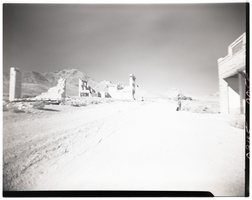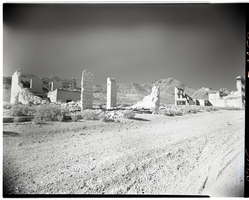Search the Special Collections and Archives Portal
Search Results
Deserted buildings on Main Street, Rhyolite, Nevada, approximately 1920
Level of Description
File
Archival Collection
Charles Thomas-Perry Photograph Collection
To request this item in person:
Collection Number: PH-00150
Collection Name: Charles Thomas-Perry Photograph Collection
Box/Folder: Folder 01
Collection Name: Charles Thomas-Perry Photograph Collection
Box/Folder: Folder 01
Archival Component
Rhyolite Ghost Casino in the old railroad depot, approximately 1939
Level of Description
File
Archival Collection
Charles Thomas-Perry Photograph Collection
To request this item in person:
Collection Number: PH-00150
Collection Name: Charles Thomas-Perry Photograph Collection
Box/Folder: Folder 05
Collection Name: Charles Thomas-Perry Photograph Collection
Box/Folder: Folder 05
Archival Component
Bessie Moffat at home, Rhyolite, Nevada: photographic slide, 1971
Level of Description
Item
Archival Collection
Nan Doughty Photograph Collection
To request this item in person:
Collection Number: PH-00240
Collection Name: Nan Doughty Photograph Collection
Box/Folder: Binder PB-007
Collection Name: Nan Doughty Photograph Collection
Box/Folder: Binder PB-007
Archival Component
Postcard of "The Ghost Town of Rhyolite, Nevada", 1951 December 25
Level of Description
File
Archival Collection
Doris Hancock Photograph Collection
To request this item in person:
Collection Number: PH-00003
Collection Name: Doris Hancock Photograph Collection
Box/Folder: Folder 02 (Restrictions apply)
Collection Name: Doris Hancock Photograph Collection
Box/Folder: Folder 02 (Restrictions apply)
Archival Component
Postcard of "The Ghost Town of Rhyolite, Nevada", 1951 December 25
Level of Description
File
Archival Collection
Doris Hancock Photograph Collection
To request this item in person:
Collection Number: PH-00003
Collection Name: Doris Hancock Photograph Collection
Box/Folder: Folder 05 (Restrictions apply)
Collection Name: Doris Hancock Photograph Collection
Box/Folder: Folder 05 (Restrictions apply)
Archival Component
Rhyolite Board of Trade promotional sheet, 1906 October 26
Level of Description
File
Archival Collection
C. A. Earle Rinker Papers
To request this item in person:
Collection Number: MS-00514
Collection Name: C. A. Earle Rinker Papers
Box/Folder: Oversized Box 12
Collection Name: C. A. Earle Rinker Papers
Box/Folder: Oversized Box 12
Archival Component
Postcard: Prospecting outfit, Rhyolite, Nevada, approximately 1900-1939
Level of Description
File
Archival Collection
University of Nevada, Las Vegas Photograph Collection
To request this item in person:
Collection Number: PH-00062
Collection Name: University of Nevada, Las Vegas Photograph Collection
Box/Folder: Folder 3
Collection Name: University of Nevada, Las Vegas Photograph Collection
Box/Folder: Folder 3
Archival Component

Film transparency of a boy looking at an abandonded building, Rhyolite, Nevada, November 25, 1948
Date
1948-11-25
Archival Collection
Description
A young boy looks at the ruins of the H. D. and L. D. Porter Brothers Store in Rhyolite, Nevada. Several other buildings are visible in the background. Rhyolite is a ghost town in Nye County, Nevada. It is in the Bullfrog Hills, about 120 miles (190 km) northwest of Las Vegas, near the eastern edge of Death Valley. The town began in early 1905 as one of several mining camps that sprang up after a prospecting discovery in the surrounding hills. During an ensuing gold rush, thousands of gold-seekers, developers, miners and service providers flocked to the Bullfrog Mining District. Many settled in Rhyolite, which lay in a sheltered desert basin near the region's biggest producer, the Montgomery Shoshone Mine. Rhyolite declined almost as rapidly as it rose. After the richest ore was exhausted, production fell. The 1906 San Francisco earthquake and the financial panic of 1907 made it more difficult to raise development capital. In 1908, investors in the Montgomery Shoshone Mine, concerned that it was overvalued, ordered an independent study. When the study's findings proved unfavorable, the company's stock value crashed, further restricting funding. By the end of 1910, the mine was operating at a loss, and it closed in 1911. By this time, many out-of-work miners had moved elsewhere, and Rhyolite's population dropped well below 1,000. By 1920, it was close to zero. After 1920, Rhyolite and its ruins became a tourist attraction and a setting for motion pictures. Most of its buildings crumbled, were salvaged for building materials, or were moved to nearby Beatty or other towns, although the railway depot and a house made chiefly of empty bottles were repaired and preserved. The town is named for rhyolite, an igneous rock composed of light-colored silicates, usually buff to pink and occasionally light gray. It belongs to the same rock class, felsic, as granite but is much less common.
Image

Film transparency of buildings located on Golden Street, Rhyolite, Nevada, November 25, 1948
Date
1948-11-25
Archival Collection
Description
Two buildings that were located on Golden Street in Rhyolite, Nevada. The building on the left was possibly the John T. Overbury building. The building on the right was the John S. Cook & Co. Bank building. Rhyolite is a ghost town in Nye County, Nevada. It is in the Bullfrog Hills, about 120 miles (190 km) northwest of Las Vegas, near the eastern edge of Death Valley. The town began in early 1905 as one of several mining camps that sprang up after a prospecting discovery in the surrounding hills. During an ensuing gold rush, thousands of gold-seekers, developers, miners and service providers flocked to the Bullfrog Mining District. Many settled in Rhyolite, which lay in a sheltered desert basin near the region's biggest producer, the Montgomery Shoshone Mine. Rhyolite declined almost as rapidly as it rose. After the richest ore was exhausted, production fell. The 1906 San Francisco earthquake and the financial panic of 1907 made it more difficult to raise development capital. In 1908, investors in the Montgomery Shoshone Mine, concerned that it was overvalued, ordered an independent study. When the study's findings proved unfavorable, the company's stock value crashed, further restricting funding. By the end of 1910, the mine was operating at a loss, and it closed in 1911. By this time, many out-of-work miners had moved elsewhere, and Rhyolite's population dropped well below 1,000. By 1920, it was close to zero. After 1920, Rhyolite and its ruins became a tourist attraction and a setting for motion pictures. Most of its buildings crumbled, were salvaged for building materials, or were moved to nearby Beatty or other towns, although the railway depot and a house made chiefly of empty bottles were repaired and preserved. The town is named for rhyolite, an igneous rock composed of light-colored silicates, usually buff to pink and occasionally light gray. It belongs to the same rock class, felsic, as granite but is much less common.
Image
Remnants of buildings located in Rhyolite, Nevada, approximately 1910-1929
Level of Description
File
Archival Collection
L. F. Manis Photograph Collection
To request this item in person:
Collection Number: PH-00100
Collection Name: L. F. Manis Photograph Collection
Box/Folder: Box 06
Collection Name: L. F. Manis Photograph Collection
Box/Folder: Box 06
Archival Component
Pagination
Refine my results
Content Type
Creator or Contributor
Subject
Archival Collection
Digital Project
Resource Type
Year
Material Type
Place
Language
Records Classification
